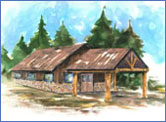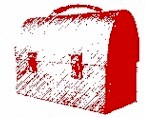
Safety is no accident.
- Anonymous
According to the U.S. Department of Labor, worker carelessness and neglect of good safety practices cause 80% of job site injuries. Few problems can affect your project more adversely than the death or injury of one of the crew members or a neighbor's child. Encouraging an interest in safety may be the most important of your Project Management responsibilities.

In 1970, Congress passed the Occupational Safety and Health Act "...to assure so far as possible every working man and woman in the nation safe and healthful working conditions and to preserve our human resources." The agency with primary responsibility for worker safety was created in the Department of Labor and is called the Occupational Safety and Health Administration. In each State, a similar governmental agency is mandated with responsibility for worker safety. What's important to note is that these Federal and State agencies have developed and published standards for safe and healthy working conditions, and it is your responsibility to be familiar with these standards.
The most common construction fatalities are: falling from a roof or ladder, being struck by an object or equipment,, and receiving an electrical shock. These common fatalities can be avoided by proper use of tools, ladders, and personal protection equipment.
The following checklist is a general guideline. A more comprehensive guide is available from your State's Department of Labor and Industries and the Occupational Safety and Health Administration which outlines safety standards for construction work. Write or call for safety standards prior to construction. You should allow ample time to develop a SAFETY PLAN for the unique circumstances surrounding your project.
SAFETY CHECKLIST
___Arrange for a portable toilet on site.
___Provide adequate drinking water.
___Safety rules communicated to each Trade Contractor.
___Accessible first-aid kit available.
___Certified first-aid personnel available on site.
___Phone numbers for police, ambulance, and fire station.
___Temporary electrical service grounded.
___All electrical tools grounded.
___All electrical cords kept away from water.
___Use listed, labeled, or certified equipment in accordance with manufacturer's instructions.
___Warning and danger signs posted in appropriate areas.
___Hard hats and steel tipped shoes worn where needed.
___Cap protruding steel rebar to eliminate hazard of impalement.
___Careful ladder use.
___Power tools with proper guards in place.
___Protective gear available such as goggles, gloves, and respirators.
___Always use protective goggles when flying fragments are possible.
___Require wearing of personal protective equipment.
___Set a good example as a safety minded individual.
___Adequate slope on edges of all ditches and trenches over four feet deep.
___Place excavated material at least two feet from edge of ditches and trenches.
___Open holes and trenches fenced properly.
___Open holes in sub-floor properly covered or protected.
___Safe access for all types of scaffolds.
___Guardrails provided for open-sided floors or platforms.
___Workers on roof with proper equipment.
___Stair rail system constructed on stair ways of four or more risers.
___Excess and/or flammable scrap not left lying around.
___General housekeeping must be on-going as the job progresses.
___No nails sticking-out of boards or other materials.
___Use approved containers or tanks for storing or handling flammable or combustible liquids.
___Gas cans and other flammable liquids to remain in secure area.
___Welding tanks shut off tightly when not in use.
___Stored secure in upright position.
___Area where soldering work performed checked for smoldering or burning wood.
___Proper clearance from all power lines.
___Spread oily or paint rags outside to dry so they will not ignite.
___Material Safety Data Sheet on site for hazardous chemicals.
___Frequent, daily safety checks are most effective.
ACCIDENTS ARE CAUSED!
Accidents don't occur without reason. There are two reasons accidents happen: either workplace conditions are unsafe or workplace actions are unsafe.
Typical unsafe conditions:
* Defective equipment and tools
* Clutter from poor housekeeping
* Exposure to hazardous substances
* Poor layout of work and storage areas
* Lack of proper protective clothing and gear
Typical unsafe actions:
* Using the wrong equipment or tool
* Rushing to complete task
* Failure to observe warning labels
* Following improper work procedures
* Not wearing personal protective equipment
Together, unsafe conditions and unsafe actions create hazards. Job hazards are most likely to cause a problem and the point is to identify each hazard and create actions to correct the problem. The Ownerbuilder (or General Contractor if you're hiring a GC) is directly liable for safety hazards.
As an Ownerbuilder, you should have Course of Construction Insurance covering your building site and accidents which may occur. You'll want insurance coverage against loss due to theft, vandalism, and fire on your residence. Coverage should also be provided for personal injury of yourself and others. However, you are NOT HIRING EMPLOYEES. You are contracting with specialty Trade Contractors to perform each phase of work on your project.
Each Trade Contractor, besides showing evidence of license and bond, will provide proof of Builder's Liability Insurance for the project and Worker's Compensation for their employees to cover their risk while working on your project. If you're not acting as an Ownerbuilder but hiring a General Contractor, the GC must also show evidence of license, bond, liability insurance, and workman's compensation coverage.
How can a SAFETY PLAN be implemented? Most important is the leadership you provide to the entire construction organization. This begins at your first meeting with a Trade Contractor to discuss your project and solicit a bid proposal. Mention your commitment to safety rules and procedures emphasizing their incorporation into site operations. As negotiations progress, include language in the "Conditions" portion of Contract Documents which stipulate compliance with federal, state, and local safety regulations. For each Trade Contractor there must a clear assignment of responsibility to a designated field superintendent.
Next, post signs on your project indicating site hazards. "Danger" and "Caution" signs should only be placed in areas where an immediate or potential hazard exists. It does no good to plaster warnings around the site in a ridiculous manner. Also, post a sign adjacent to the phone on site listing emergency phone numbers such as a local physician, hospital, ambulance, fire department, and police station. Another important precaution is to collect a Material Safety Data Sheet for all hazardous substances being used on your project and start a SAFETY FILE. This is a ready reference when using materials with possible hazardous substance exposures.
Another procedure is to keep on site an approved first-aid kit which is accessible to all Trade Contractors. In addition, each Trade Contractor should provide their own first-aid kit. Ask each contractor if their field superintendent is trained and certified to offer first-aid. If not, suggest ways to make medical services immediately available should an injury occur.
For a SAFETY PLAN to be effective, the Owner and Trade Contractors must be committed to safety. This commitment is primarily attitudinal representing a set of values which recognize the worth of human life and endeavor. Posting slogans and phone numbers or paying lip service to the idea of safety does nothing to directly correct a problem. Look for ways to improve the work place by anticipating hazards on a daily basis.
Safety must be integrated into the production of the house from the standpoint of methods, materials, and machines.
| 



